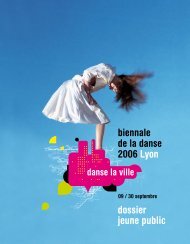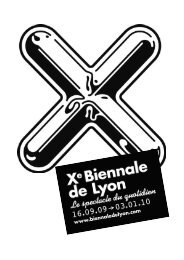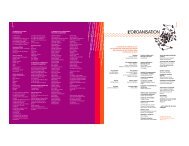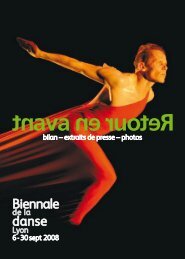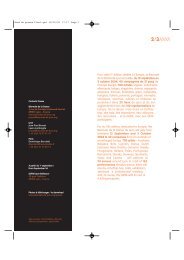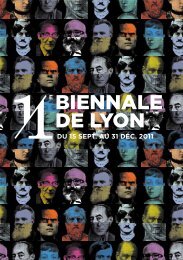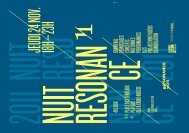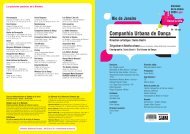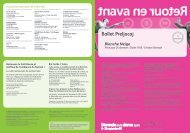Retour en Avant / Past Forward Biennale de la Danse Lyon - France
Retour en Avant / Past Forward Biennale de la Danse Lyon - France
Retour en Avant / Past Forward Biennale de la Danse Lyon - France
- No tags were found...
Create successful ePaper yourself
Turn your PDF publications into a flip-book with our unique Google optimized e-Paper software.
ses : l’Art Foundation <strong>en</strong> 1998, le Time OutAward <strong>en</strong> 2001 et <strong>en</strong> 2003, et un OlivierAward pour sa performance 2Human <strong>en</strong>2004.Entity: A DiptychEntity: A diptych confronte l’énergierythmée du Quatuor Debussy aux aspéritéssonores et aux mélodies électroniques<strong>de</strong> Jon Hopkins. Associant <strong>la</strong> danse et<strong>la</strong> sci<strong>en</strong>ce, le concept d’Entity est né <strong>de</strong>l’affinité que Random a <strong>en</strong>tret<strong>en</strong>ue avec <strong>la</strong>p<strong>en</strong>sée sci<strong>en</strong>tifique. Le diptyque est le fruitd’une col<strong>la</strong>boration <strong>en</strong>tre McGregor et Scott<strong>de</strong> Lahunta, <strong>de</strong> l’University of California <strong>de</strong>San Diego, <strong>en</strong> association avec The CaliforniaInstitutes for Sci<strong>en</strong>ce and Innovation,The Neurosci<strong>en</strong>ces Institute, Salk Institute etThe Kavli Institute for Brain and Mind. Entravail<strong>la</strong>nt avec <strong>de</strong>s chercheurs interdisciplinaires<strong>en</strong> sci<strong>en</strong>ces cognitives - <strong>en</strong>globant <strong>la</strong>psychologie, les neurosci<strong>en</strong>ces, <strong>la</strong> linguistique,l’interaction homme-ordinateur, <strong>la</strong>robotique, etc. McGregor et son équipe ontcréé un système d’ag<strong>en</strong>ts intellig<strong>en</strong>ts capablesd’appr<strong>en</strong>dre et <strong>de</strong> trouver <strong>de</strong>s solutionsoriginales à <strong>de</strong>s problèmes chorégraphiques.En poussant les limites du corps technologique,un dialogue complexe, <strong>en</strong>tre le cognitifet le physique, soulève <strong>de</strong>s questions sur <strong>la</strong>nature même <strong>de</strong> l’être humain.Infos +Première <strong>en</strong> <strong>France</strong>Compagnie invitée à <strong>la</strong> Bi<strong>en</strong>nale 2004www.randomdance.orgWayne McGregorMcGregor was born in Stockport in 1970 andstudied dance at University College Bretton Hal<strong>la</strong>nd at the José Limon School in New York. In1992 he foun<strong>de</strong>d his own company, rec<strong>en</strong>tlyretitled Wayne McGregor | Random Dance , andin the same year was appointed choreographerin-resid<strong>en</strong>ceat The P<strong>la</strong>ce in London. He is thefirst mo<strong>de</strong>rn dance choreographer in the historyof the Royal Ballet to be appointed as the company’sresid<strong>en</strong>t choreographer.Random was one of many small-scale companiesemerging in the 1990s, but two features ma<strong>de</strong>McGregor’s work stand out. The first was theunique quality of his vocabu<strong>la</strong>ry. This had itsorigins in McGregor’s own long, lean and supplephysique, and in its capacity to register movem<strong>en</strong>twith peculiar sharpness and speed. At oneextreme McGregor’s dancing was a jangle oftiny, fractured angles, at the other it was a whirlof seemingly boneless fluidity. The second outstandingfeature of the work was its embrace ofnew technology. McGregor started p<strong>la</strong>ying withcomputers from the age of sev<strong>en</strong> and it wasnatural for him to incorporate the cyber worldinto his own choreography. Col<strong>la</strong>borating withstate-of-the-art <strong>de</strong>signers McGregor experim<strong>en</strong>tedwith projecting computer g<strong>en</strong>erated imagesonto the stage. In Sulphur 16 (1998) Random’sdancers were dwarfed by the pres<strong>en</strong>ce of ashimmering virtual giant that was projected onthe space above them. Later in the work, a companyof digital figures appeared to weave andshimmer among the live dancers like ghostly visitorsfrom another age. In Aeon (2000) the effectof digitally created <strong>la</strong>ndscapes ma<strong>de</strong> the dancersappear to be inhabiting other dim<strong>en</strong>sions andother worlds. On specific occasions, McGregorused technology to alter the conditions un<strong>de</strong>rwhich his work was viewed. 53 Bytes (1997)was created for simultaneous performance bytwo groups of dancers, located in Berlin andCanada. Audi<strong>en</strong>ces in both countries watchedthe transat<strong>la</strong>ntic performance by live satellitelink. In 2000 McGregor explored the possibilitiesof an ev<strong>en</strong> more global public by transmitting alive performance of his Trilogy Instal<strong>la</strong>tion overthe internet. In all these ways McGregor haspioneered a future for dance transformed bytechnology.In 2002, Random was invited to become thecompany in resid<strong>en</strong>ce at Sadler’s Wells. McGregorcelebrated his new home with Nemesis(2002), which p<strong>la</strong>yed with a very differ<strong>en</strong>t kindof technology. Mid-way through, its cast weretransformed into a hybrid super race by havinglong mechanical limbs attached to their arms.Part weapon, part prosthetic body part, thesestrangely jointed, freakishly articu<strong>la</strong>te <strong>de</strong>vicesl<strong>en</strong>t the dancers and the dance a mysterious,beautiful m<strong>en</strong>ace.At the same time as his work for Wayne McGregor| Random Dance, McGregor contributesto others non-dance productions (the NationalTheatre’s A Little Night Music, Harry Potterand the Goblet of Fire for Warner Bros). Healso creates new ballets for other companies,including San Francisco Ballet, Paris Ballet, NDT Iand English National Ballet. McGregor ma<strong>de</strong> hisdirectorial <strong>de</strong>but at La Sca<strong>la</strong>, Mi<strong>la</strong>n, with Didoand A<strong>en</strong>eas in 2007, and, <strong>la</strong>ter on that year, atthe Maison <strong>de</strong> <strong>la</strong> <strong>Danse</strong> with the musical Kirikou& Karaba. He has also ma<strong>de</strong> numerous worksfor television.McGregor draws direct inspiration from his dancersbut music is important to his process too.The t<strong>en</strong>se futuristic worlds of his earliest workswere ma<strong>de</strong> edgier by their accompanim<strong>en</strong>t byabrasive club music; however, in his <strong>la</strong>ter works,McGregor began to exploit the emotionalcolour of an increasingly wi<strong>de</strong> variety of music,regu<strong>la</strong>rly commissioning new composers to writepieces for his work.Amu was inspired by McGregor’s interest inthe functions and the symbolism of the heart,and has be<strong>en</strong> part of his ongoing study of theinternal workings of the human body. In 2004Wayne McGregor was appointed ResearchFellow with the Neurosci<strong>en</strong>ce Departm<strong>en</strong>t ofCambridge University, where he was <strong>en</strong>gaged ina project to investigate the re<strong>la</strong>tionship betwe<strong>en</strong>brain and physical states in the creative processesof dance.McGregor’s experim<strong>en</strong>ts have earned him astring of nominations and awards, including anArts Foundation Fellowship in 1998; two TimeOut Awards for Outstanding Achievem<strong>en</strong>t, in2001 and 2003; and an Olivier Award in 2004.Entity: A DiptychEntity: A diptych of works by visionary choreographerWayne McGregor, pitches the rhythmic<strong>en</strong>ergy of the Debussy Quartet against the sonicextremes of Jon Hopkins melody-led electronica.Entity is a new dance/sci<strong>en</strong>ce col<strong>la</strong>boration thathas evolved from Random’s past and intimate<strong>en</strong>gagem<strong>en</strong>t with sci<strong>en</strong>tific thought. For thisdiptych, McGregor col<strong>la</strong>borated with Scott <strong>de</strong>Lahunta and the University of California at SanDiego in association with the California Institutesfor Sci<strong>en</strong>ce and Innovation, the Neurosci<strong>en</strong>cesInstitute, Salk Institute and the Kavli Institute forBrain and Mind. Working with researchers fromthe interdisciplinary fields of cognitive sci<strong>en</strong>ce –psychology, neurosci<strong>en</strong>ces, linguistics, humancomputerinteraction, robotics etc. – McGregorand his team built Entity – a “learning” ag<strong>en</strong>t,or collection of ag<strong>en</strong>ts – which can g<strong>en</strong>erateunique solutions to choreographic problems,while continually testing the capacities of thetechnological body in a complex cognitive andphysical <strong>de</strong>bate that questions the very nature ofwhat it is to be human.Extra info:Fr<strong>en</strong>ch PremiereThe company performed at the2004 Bi<strong>en</strong>nalewww.randomdance.org19






